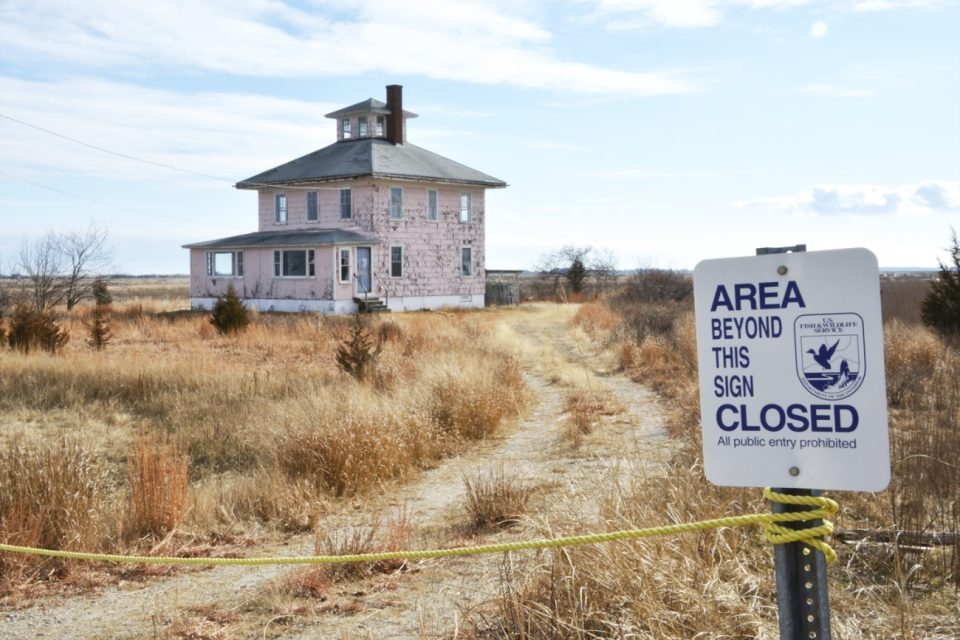PLUM ISLAND TURNPIKE – Maybe the non-profit Support the Pink House organization (STPH) could take a page from the Salisbury Historical Commission and propose to the U.S. Fish & Wildlife Service (F&WS) that it license the almost 100-year-old icon while the community maintains the house.
The F&WS currently plans to tear down the Pink House and replace it with benches and possibly an observation platform to view the marsh.
In STPH’s well-attended meeting last week at PITA Hall on Plum Island, frustrations with the F&WS boiled over, prompting one supporter to call for Matt Hellman, the director of the Parker River Wildlife Refuge, to resign.
Suzann Dee, a Pink House supporter, wrote on Facebook, “It’s shameful to read the absolute nonsense the Parker refuge has been allowed to put out as official statements from a governmental agency. They are hoodwinking everyone.”
In its Environmental Assessment of the Pink House, Hellman wrote: “While we regret not reaching an outcome that satisfies all, we’re confident the decision aligns with our mission to protect and restore high-quality wildlife habitat and provide meaningful educational opportunities.”
Constructed in 1925, the Pink House is a three-bedroom, two-story former private residence on the Plum Island Turnpike in Newbury, surrounded by the salt marsh and tidal creek.
At the government agency’s suggestion, the STPH has sent five possible land parcels that could be traded for the Pink House. All five parcels, which met most of the criteria the agency set, have been rejected.
Across the Merrimack River, the Salisbury commission last week sent a proposed draft of a 10-year license from the U.S. Coast Guard for the Butler’s Toothpick, a navigation marker on the river, to the SelectBoard and Town Manager Neil Harrington.
The Coast Guard’s is asking the town to buy a liability insurance policy for the marker, officially named the Black Rock Day Beacon, that has been guiding mariners along the river since 1873.
“The Coast Guard is enthusiastic. It would like to have the Toothpick restored,” said Connie Hellwig, chair of the Salisbury Historical Commission recently. After talking with Coast Guard officials for six years, she said licensing the Toothpick is a workable solution.
The commission’s plan is to rebuild the Toothpick to its original height of 35 feet and 20 feet wide.
When asked about licensing the Pink House, Nick Anastasi, an attorney with the Pierce Atwood firm, said licensing it from the federal government is one option the F&WS lists in its regulations, but has never pursued.
The F&WS posted its draft Environmental Assessment of the Pink House after the 30-day public comment period gave supporters little hope it could be saved. The agency declared the comments offered “No Significant Impact” on its plan to demolish the Pink House, although 78 percent of the public comments advocated for the federal agency to preserve the Pink House.
“So none of that comment period was ever going to be taken seriously?” asked Susann Dee.
The F&WS wrote that it did make “notable improvements” to its plan, including offering to put the Pink House up for auction. “If successful, the community could continue drawing inspiration from it at another site or in another form,” the agency wrote.
Jeff Ackley, the STPH treasurer, said in an earlier interview that moving the Pink House off its isolated location on the edge of the salt marsh would greatly reduce the scenic appeal of one of the most painted and photographed buildings on the North Shore.
The federal agency maintains in its assessment that it has conducted “an exhaustive search” for the last seven months for a suitable property that could be exchanged for the house and 1 acre it sits on.
“No viable exchange parcels were located,” the environmental assessment states.
Could the Pink House Be Licensed?
Tuesday April 16, 2024




